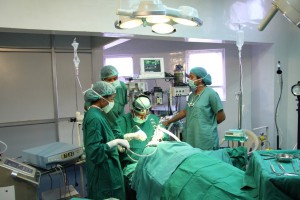
The family was relieved to learn that minimally invasive surgery was an option for the child. The family went through all the research and saw things like spinal fusion. Some of the treatment options were more constrictive, like bracing for 23 hours per day, which would be really challenging and limiting in and of it. Having an alternative that fit the girl’s lifestyle was a huge, huge comfort for them.
Scoliosis is a condition that causes the spine to curve in an S or C shape. Bracing is often recommended for patients, but that is not always effective. For some patients, the curvature progresses aggressively and more invasive procedures are required. Vertebral body stapling is a minimally invasive procedure for patients with earlier onset scoliosis.
Surgeons apply metal staples to the anterior, or the side of the spine that faces forward. They are inserted between two vertebral bodies, which compress the growth plates and slow the growth of that side of the spine, allowing the scoliosis to “self correct,” similar to orthodontic braces for teeth.
The staples ar
What the team is trying to do is preserve the long-term motion of the spine. Patient selection, however, is crucial. One has to pick the appropriate patient with the right curvature.
That makes early diagnosis all the more critical. The child was diagnosed with scoliosis three years ago during a routine pediatric checkup for Girl Scout camp. They had her touch her toes and noticed a slight visible difference. During adolescence, growth spurts can transform slight spinal curvatures into significant ones, ruling out minimally invasive procedures like the body stapling. Early screening gives people the maximum amount of options.
When the girl was first diagnosed with scoliosis three years ago, she didn’t know much about the disease. The family did a lot of research and lots and lots of X-rays. They started to understand and grasp everything.
After the diagnosis, she wore a back brace to bed, decorated with stickers and signatures from friends, but that didn’t do much to correct the curvature. When doctors told her she was a candidate for a minimally invasive procedure that would make it easier to dance and play sports, she jumped at the prospect.
The surgeon performed the surgery through three small incisions, one centimeter in size. The child was hospitalized for only three days, returned to her daily activities within a week and was back at gym class in about four weeks. From the X-rays, the top curve has corrected nine degrees and the bottom curve has corrected 10 degrees.
Her family is hopeful that the early detection and surgery will help prevent future problems. They are optimistic the child can avoid the more invasive surgery in the future.
For more information on Scoliosis Surgery please visit https://safemedtrip.com/medical-services/spine-surgery-treatment-in-india/scoliosis-surgery-in-india.html

 Click to WhatsApp
Click to WhatsApp +91-9899993637
+91-9899993637



